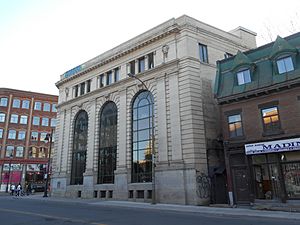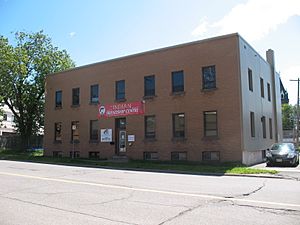Native Friendship Centre facts for kids
Friendship Centres are special places in Canada that help Indigenous people who live in cities. These include Inuit, Métis, and First Nations individuals. They are like community hubs that offer many different programs and services.
Friendship Centres are non-profit organizations, meaning they don't aim to make money. They provide things like youth programs, health services, help with housing, job support, and cultural activities. There are over 100 of these centres all across Canada today.
Contents
How Friendship Centres Started
Friendship Centres began in the 1950s. At that time, many Indigenous people were moving from their home communities to cities. This often happened because of government policies that made it difficult for them to stay in their traditional areas. These policies encouraged them to relocate to towns and cities.
People saw a need for places where Indigenous people could find support and connect with their culture in these new urban settings. So, they started creating these centres.
Some of the very first Friendship Centres included:
- The North American Indian Club in Toronto, Ontario, started in 1951.
- The Coqualeetza Fellowship Club in Vancouver, British Columbia, opened in 1952.
- The Indian and Métis Friendship Centre in Winnipeg, Manitoba.
By 1968, there were 26 Friendship Centres in Canada. This number grew to 80 by 1983, and then to 118 by 2009.
Groups That Support Friendship Centres
Friendship Centres are part of a larger network. They are supported by different groups at the national and provincial levels. These groups are called Provincial Territorial Associations (PTAs).
There are several PTAs, including:
- The National Association of Friendship Centres (NAFC)
- Ontario Federation of Indigenous Friendship Centres (OFIFC)
- Aboriginal Friendship Centres of Saskatchewan
- Manitoba Association of Friendship Centres
- Alberta Native Friendship Centres Association
- BC Association of Aboriginal Friendship Centres
- Northwest Territories/Nunavut Council of Friendship Centres
National Association of Friendship Centres
The National Association of Friendship Centres (NAFC) was created in 1972. Its main job is to represent all the Friendship Centres across Canada. It helps them work together and speaks for them to the government and the public.
The NAFC is guided by a group of leaders called a Board of Directors. This board includes representatives from different regions and a youth representative. There's also a smaller group called the Executive Committee that helps make decisions.
The NAFC also keeps an eye on what the government is doing. This helps make sure that programs and money meant for urban Indigenous people are used well. The NAFC also helps centres share information and connect with other groups. They work on important topics like education, fighting racism, and helping with jobs.
Programs and Services Offered
Friendship Centres welcome everyone, no matter their background. They offer many programs and services that are respectful of Indigenous cultures.
When you visit a Friendship Centre, you might find:
- Help finding other services or speaking up for yourself.
- Cultural programs, like traditional teachings or ceremonies.
- Education and training opportunities.
- Job search help and career advice.
- Health and wellness programs.
- Support for children and youth, including summer camps and daycares.
- Fun recreation programs and sports leagues.
- Language training and computer classes.
- Support for healthy living.
- Healing circles and youth drop-in centres.
Many centres also have shops where you can buy Indigenous arts and crafts. They often organize special events like pow-wows throughout the year. Friendship Centres help over 1.3 million people across Canada every year!
The Senate of the Movement
The Friendship Centre Movement also has a group of advisors called Senators. These individuals are respected for their wisdom and experience. They help guide the movement by sharing their knowledge of its past and values. Senators attend important meetings to offer advice to the leaders.
Aboriginal Youth Council
The Aboriginal Youth Council (AYC) is a group for young people aged 14 to 24. They talk about important issues for youth. These include staying in school, health and wellness, preserving culture, and leadership. The AYC makes sure that young people's voices are heard in the decisions made by the Friendship Centre Movement.
How Friendship Centres Get Funding
In 1972, the Government of Canada officially recognized how important Friendship Centres were. They started a program called the Migrating Native Peoples Program (MNPP). This program gave money to 40 Friendship Centres and the NAFC to help them operate.
Over the years, this funding program changed names and grew.
- In 1983, it became the Native Friendship Centre Program (NFCP).
- In 1988, it was renewed as the Aboriginal Friendship Centres Program (AFCP). This program became a permanent way for centres to get funding.
A big change happened in 1996. The NAFC took over the job of managing the money for the AFCP. This meant that the NAFC now gives the operational funding directly to the local Friendship Centres and the PTAs.
See also



